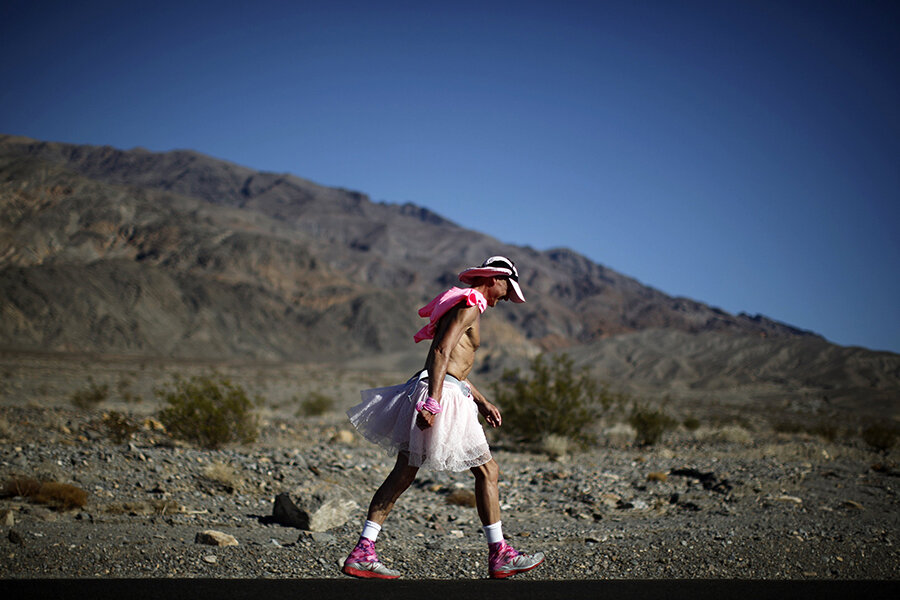'Conquering' the Runfire Cappadocia ultra marathon takes more than just muscle
Loading...
Karla Bruning, an announcer for the New York City Marathon, recently completed the first leg of the Runfire Cappadocia Marathon in Uchisar, Turkey, a 160-mile-long, seven-day ultra marathon.
Ms. Bruning is just one of thousands of athletes, and a growing number of female competitors, who are attracted to this simple, extreme sport. According to UltraRunning Magazine, almost 70,000 people finished races 30 miles or longer in 2013, up from less than 3,000 in 1980.
"We shouldn't be calling this risk-taking. We should be calling this normal, and society we should call 'safety seeking,'" said Eric Brymer, an extreme sports researcher at the Queensland University of Technology in Australia, in a 2010 interview with The Christian Science Monitor. "I think a lot of what is going on in society that is negative is because we are not really living what we are capable of living."
Writer and ultra marathoner Christopher McDougall argues in his book 'Born to Run' that when we are running with a goal in mind, such as greater fitness, the road seems long, but when we run for the sake of running, as people did generations before civilization, the race becomes easy, even enjoyable.
OA Sports Medicine, a journal in London, has also done research into the rise in ultra marathon participation, noting most specifically the increase in female runners over a twelve-year period.
One of the races that they studied, the so-called ‘Badwater’ race in California's Death Valley, was also noted by Mr. McDougall for its competitive nature, grueling environment, and lack of external support.
Yet the number of female finishers at Badwater increased from zero to 12 percent in 2012. The study's researchers noted that for male competitors who did well in Badwater and Spartathalon – another ultra marathon event held in Greece – their primary goal of participation was to achieve both social status and recognition from peers.
They also noted that the so-called "master runner" – the runner who "dominated performance" – was typically, although not always, a well-educated man.
Runner’s World explains some of the reasons why women’s numbers aren't rising faster in ultra marathoning include “factors like childbearing, family obligations, work commitments, and safety concerns while training on isolated trails could deter many.”
Gary C. David and Nick Lehecka, both from the University of Texas at Arlington, have written with concern about ultra marathoning’s new popularity, commenting that “Increased size comes with increased challenges of socialization and indoctrination into how things are supposed to be done, and a shared sense of self and practice is no longer safely assumed.” They write that ultra marathoning could eventually attract prize money and sponsorships in the same way that climbs to Mount Everest did in the 1990s and early 2000s.
Despite the risks and rewards that the dimension of sponsorship adds to ultra running, women have found it harder to attract sponsorships and generate interest in their races. Once the men finish their races and the women start theirs, it is usually later in the evening and excitement has worn down for spectators and those in the media. "This makes the atmosphere in 100K and longer less vibrant for the women's winner,” Francesca Conte, president of Bad to the Bone Endurance Sports, remarked to Runner’s World.
Bruning, however, had almost the complete opposite experience. "Of the 100 races and countless runs I've logged on six continents, none has been as hot, hilly, humbling, and exhilarating as Runfire Cappadocia," she wrote for Shape Magazine.
On her first day, Bruning got lost and was forced to stop with a DNF (Did Not Finish) when she eventually made it to the second checkpoint. But she gained something more valuable from her experience than a record-setting finish time, she says: an appreciation of the Turkish landscape and culture.
The kindness of the people she passed and her fellow runners made all the difference, Bruning writes. When she took the plunge on another day of the competition, "I teamed up with a Turkish runner named Gözde. We marveled at a crater lake, tumbled stone village, and other sites as we climbed to the race's peak elevation at 5,900 feet, more than a mile high, while the heat index climbed above 100°F," she writes. "I wanted to be an ultra marathoner for all my days."
Even though she only participated in pieces of the 160-mile race, Bruning titled her piece "What It Took to Conquer (Part of) the Runfire Cappadocia Ultra Marathon in Turkey," suggesting that she triumphed over something more than the distance.
The race website invites participants to "rediscover" themselves, and perhaps she did.
Bruning asked, "Can you call it once-in-a-lifetime if you're already dreaming about doing it again?"





